Research on Stress Characteristics of Rockburst in Over-Length Deep-Buried Tunnel
Abstract
:1. Introduction
2. Project Overview
3. Rockburst Characteristics of Ping’an Tunnel
4. Model Establishment of Rockburst Sections in Ping’an Tunnel
4.1. In Situ Stress Test during Construction
4.2. Establishment of Three-Dimensional Model
5. Stress Analysis of Rockburst Section of Ping’an Tunnel
5.1. Stress Field Analysis of Rockburst Section in Ping’an Tunnel’s Left Line
5.2. Stress Field Analysis of Rockburst Section in Ping’an Tunnel’s Right Line
6. Rockburst Conditions of Different Positions in Ping’an Tunnel
7. Conclusions
Author Contributions
Funding
Data Availability Statement
Conflicts of Interest
References
- Manouchehrian, A.; Ming, C. Numerical modeling of rockburst near fault zones in deep tunnels. Tunn. Undergr. Space Technol. 2018, 80, 164–180. [Google Scholar] [CrossRef]
- Feng, X.T.; Xu, H.; Qiu, S.L.; Li, S.J.; Yang, C.X.; Guo, H.S.; Cheng, Y.; Gao, Y.H. In situ observation of rock spalling in the deep tunnels of the China Jinping underground laboratory (2400 m depth). Rock Mech. Rock Eng. 2018, 51, 1193–1213. [Google Scholar] [CrossRef]
- Liang, W.; Sari, A.; Zhao, G.; Mckinnon, S.D.; Wu, H. Short-term rockburst risk prediction using ensemble learning methods. Nat. Hazards 2020, 5, 104. [Google Scholar] [CrossRef]
- Zucca, M.; Valente, M. On the limitations of decoupled approach for the seismic behaviour evaluation of shallow multi-propped underground structures embedded in granular soils. Eng. Struct. 2020, 211, 110497. [Google Scholar] [CrossRef]
- Ak, A.; Bas, B. Review of published rockburst events and their contributing factors—ScienceDirect. Eng. Geol. 2018, 246, 361–373. [Google Scholar]
- Kaiser, P.K.; Ming, C. Design of rock support system under rockburst condition. J. Rock Mech. Geotech. Eng. 2012, 12, 215–227. [Google Scholar] [CrossRef]
- Cai, M. Principles of rock support in burst-prone ground. Tunn. Undergr. Space Technol. Inc. Trenchless Technol. Res. 2013, 36, 46–56. [Google Scholar] [CrossRef]
- Ortlepp, W.D.; Stacey, T.R. Rockburst mechanisms in tunnels and shafts. Tunn. Undergr. Space Technol. 1994, 9, 59–65. [Google Scholar] [CrossRef]
- Qian, Q.H. Definition, mechanism, classification and quantitative forecast model for rockburst and pressure bump. Rock Soil Mech. 2014, 35, 1–6. [Google Scholar]
- Bagde, M.N.; Karekal, S. Fatigue properties of intact sandstone in pre and post-failure and its implication to vibratory rock cutting. ISRM India J. - Half Yrly. Tech. J. Indian Natl. Group ISRM 2015, 12, 19–25. [Google Scholar]
- Feng, X.T.; Xiao, Y.X.; Feng, G.L.; Yao, Z.B.; Chen, B.R.; Yang, C.X.; Su, G.S. Study on the development process of rockbursts. Chin. J. Rock Mech. Eng. 2019, 38, 649–673. [Google Scholar]
- Afraei, S.; Shahriar, K.; Madani, S.H. Developing intelligent classification models for rock burst prediction after recognizing significant predictor variables, section 1: Literature review and data preprocessing procedure. Tunn. Undergr. Space Technol. 2019, 83, 324–353. [Google Scholar] [CrossRef]
- Gong, F.Q.; Dai, J.H.; Wang, M.Y.; Huang, S.L.; Xu, L. “Strength & stress” coupling criterion its grading standard for high geostress. J. Eng. Geol. 2022, 30, 1893–1913. [Google Scholar]
- Manouchehrian, A.; Cai, M. Analysis of rockburst in tunnels subjected to static and dynamic loads. J. Rock Mech. Geotech. Eng. 2017, 48, 69–75. [Google Scholar] [CrossRef]
- Gong, F.Q.; Li, X.B. Application of distance discriminant analysis method to classification of engineering quality of rock masses. Yanshilixue Yu Gongcheng Xuebao/Chin. J. Rock Mech. Eng. 2007, 26, 190–194. [Google Scholar]
- Li, X.; Gong, F.; Wang, S.; Li, D.; Feng, F. Coupled static-dynamic loading mechanical mechanism and dynamic criterion of rockburst in deep hard rock mines. Chin. J. Rock Mech. Eng. 2019, 42, 46–53. [Google Scholar]
- He, M.; Miao, J.; Li, D.; Wang, H.C.; Chen, R.N. Rock burst in deep granite sample process experimental study. J. Rock Mech. Eng. 2007, 26, 865–876. [Google Scholar]
- Lin, M.Q.; Zhang, D.J.; Pan, D.; Xiao-Shan, N.I.; Ben-Jun, X.I.; Yang, D.D. Research on rock burst evolution and micromechanics analysis of phosphate fragments from rock burst. Ind. Miner. Process. 2017, 15, 59–66. [Google Scholar]
- Feng, T.; Xie, X.B.; Wang, W.X.; Pan, C.L. Brittleness of rocks and brittleness indexes for describing rockburst proneness. Min. Metall. Eng. 2000, 20, 18–19. [Google Scholar]
- Li, M.; Song, Y.; Lv, W.; Wang, Z.; Fang, D. Study on micro-mechanism of rockburst tendency of underground engineering rock mass. China Saf. Sci. J. 2017, 27, 89–94. [Google Scholar]
- Feng, J. Rockburst Characteristics and prevention of Erlang Mountain Tunnel. West-China Explor. Eng. 2005, 17, 110. [Google Scholar]
- Li, T.; Zhong, Y.; Pan, H.; Chen, G. Failure Characteristics Analysis on Physical Model of Rockburst in High In-situ Stress Tunnel. Mod. Tunn. Technol. 2016, 53, 185. [Google Scholar]
- Ma, T.H.; Tang, C.A.; Tang, L.X.; Zhang, W.D.; Wang, L. Mechanism of rockburst forcasting based on micro-seismic monitoring technology. Chin. J. Rock Mech. Eng. 2016, 35, 473. [Google Scholar]
- Chen, X.W.; Huang, L.; Zou, Y.L. Rapid construction technology of flexible support for rockburst tunnel. Tunn. Constr. 2018, 38, 1212. [Google Scholar]
- Yang, J.; Chai, J.; Zhang, D.; Zhang, Y.X. Study on ductile fracture mechanism of coal rock mass based on cohesive crack model. Chin. J. Rock Mech. Eng. 2021, 40, 3014–3023. [Google Scholar]
- Xie, H.P.; Pari, W.G. Fractal characteristics and mechanism of rockburst. Chin. J. Rock Mech. Eng. 1993, 12, 28–37. [Google Scholar]
- Chen, B.; Feng, X.; Ming, H.; Zhou, H.; Xiao, Y. Evolution law and mechanism of rockburst in deep tunnel: Time delayed rockburst. Yanshilixue Yu Gongcheng Xuebao/Chin. J. Rock Mech. Eng. 2012, 31, 561–569. [Google Scholar]
- Liu, G.F.; Li, S.F.; Feng, G.L. Volume of rockbursts based on seismic information classification and identification method research. Chin. J. Rock Mech. 2024, 23, 1–15. [Google Scholar] [CrossRef]
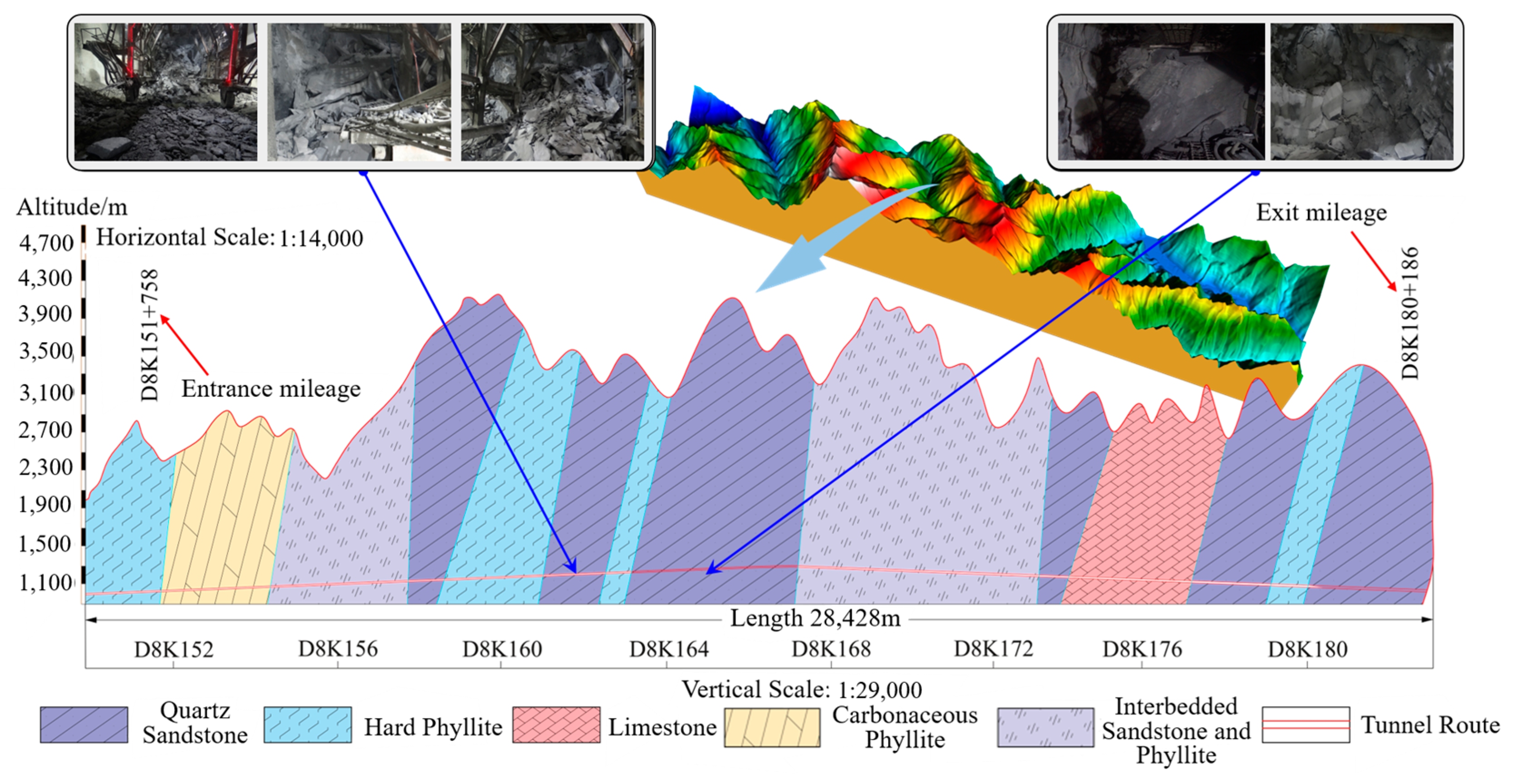
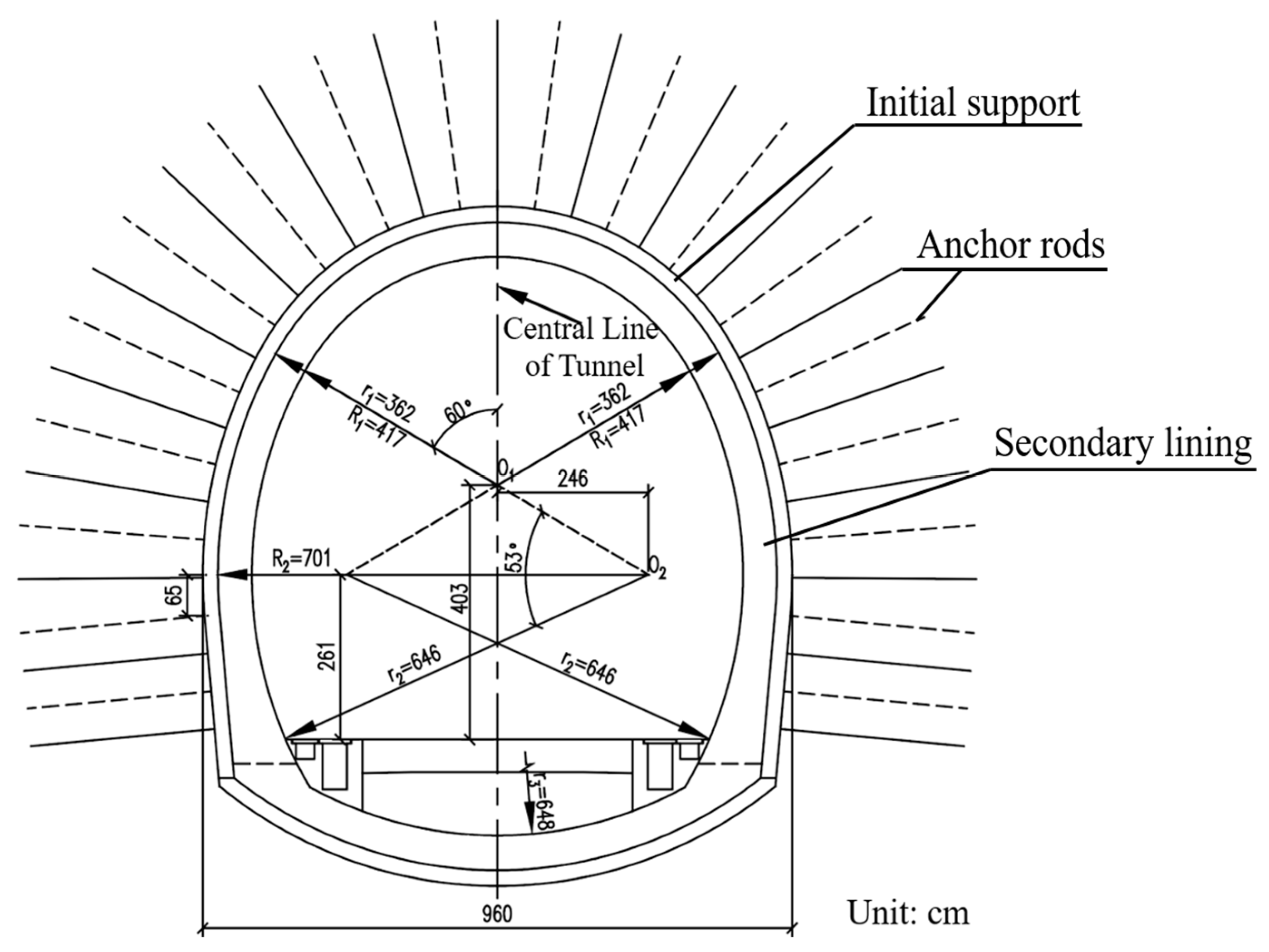
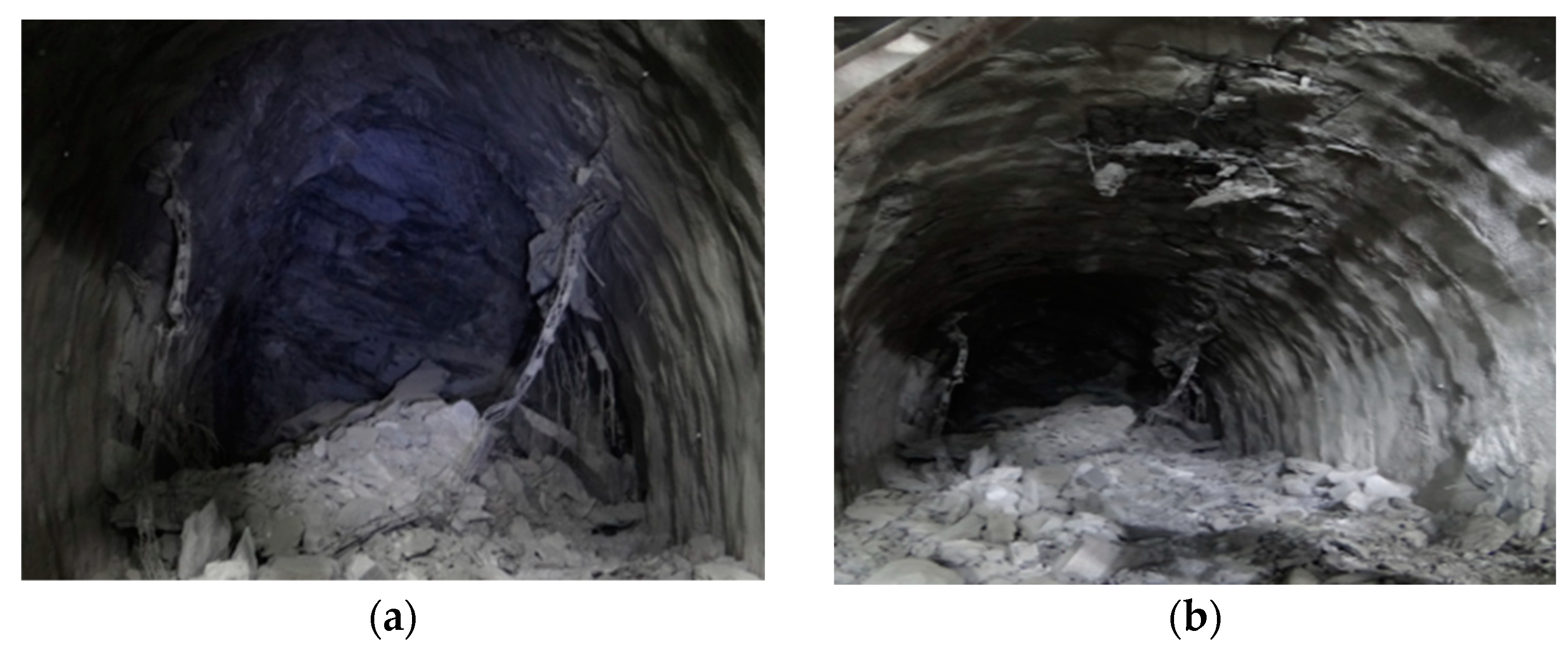
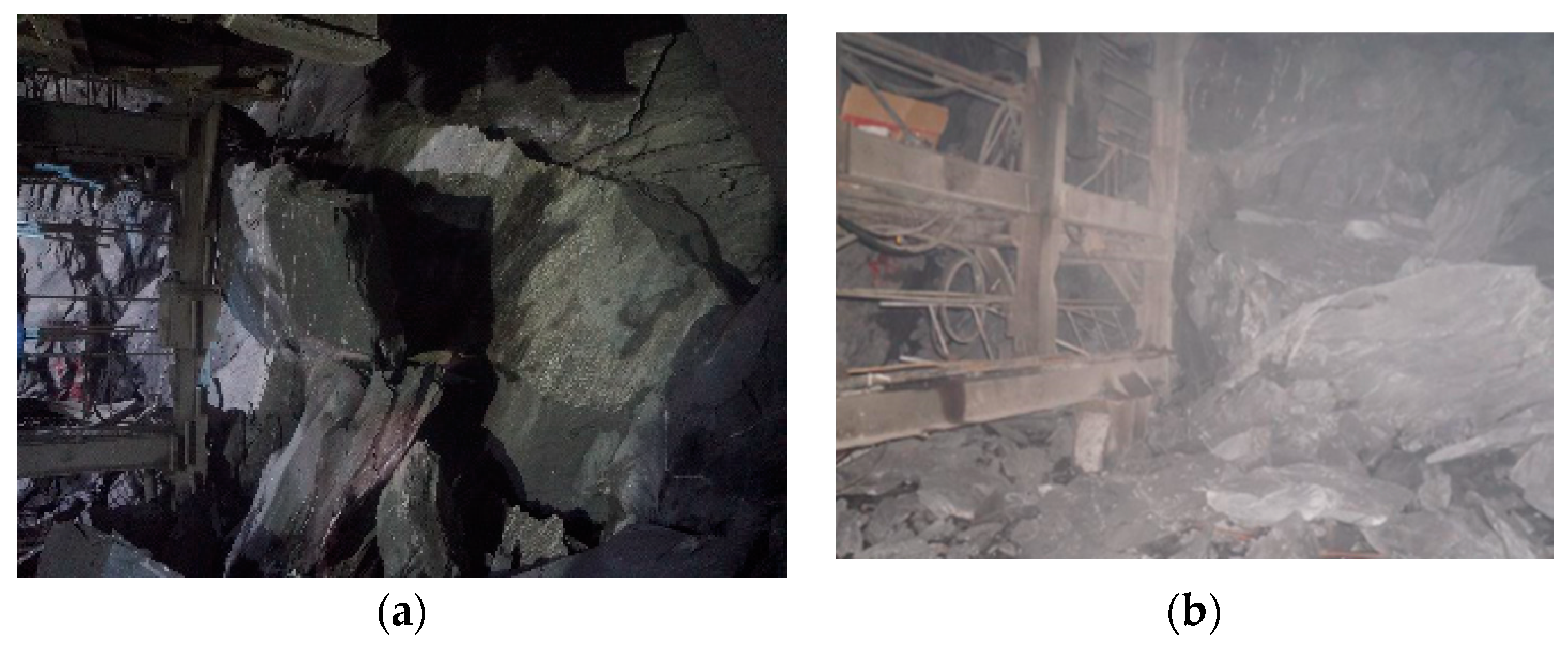
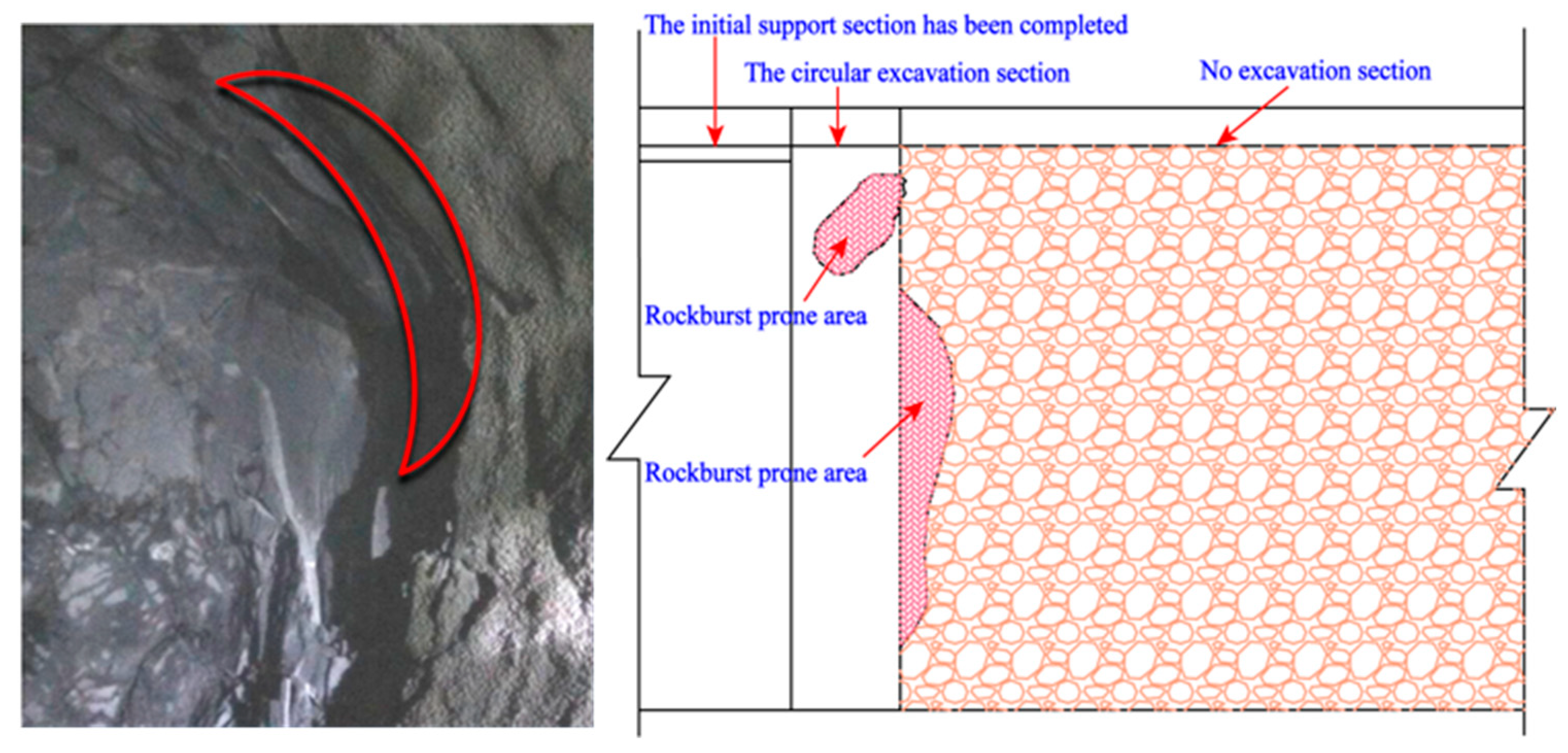
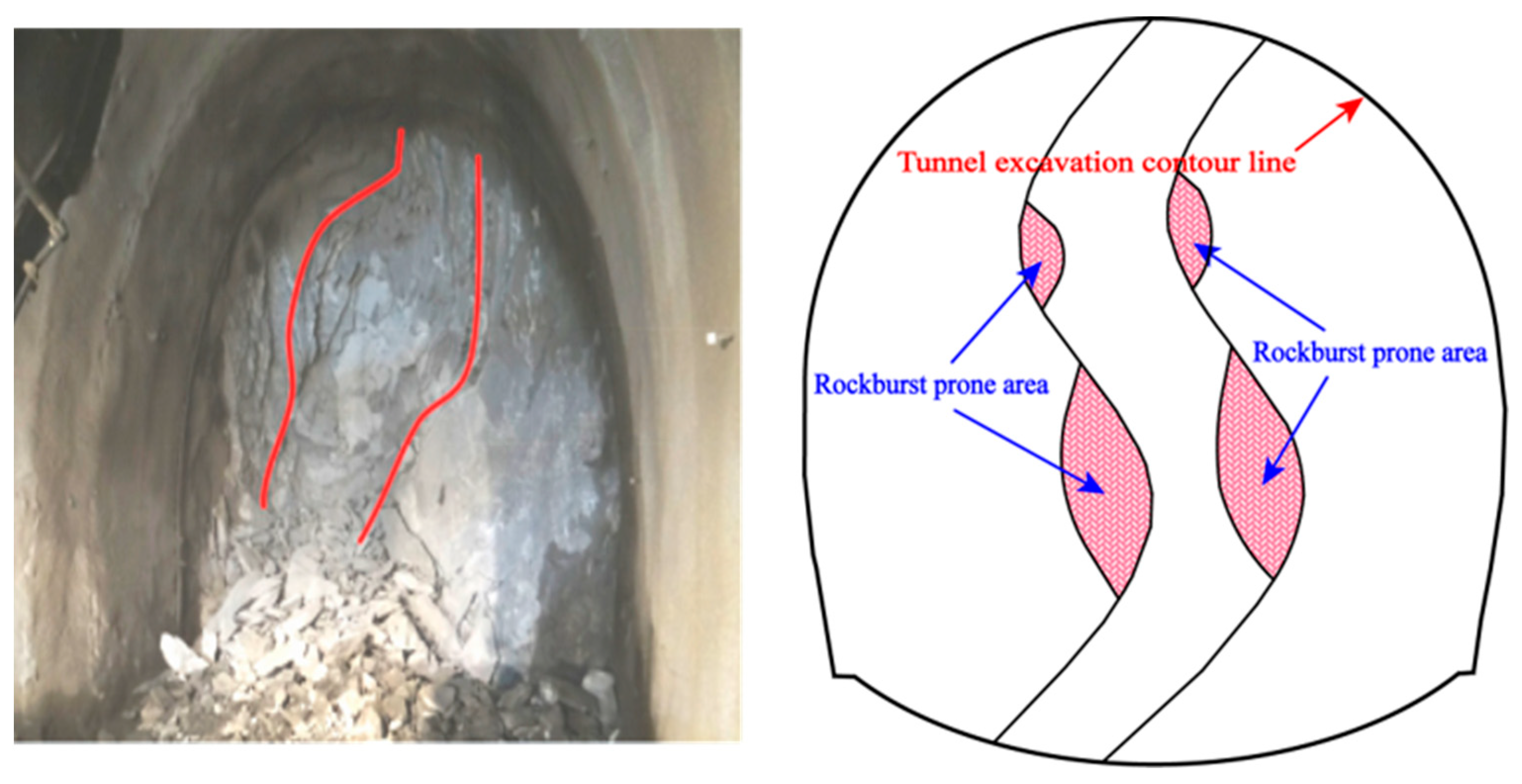
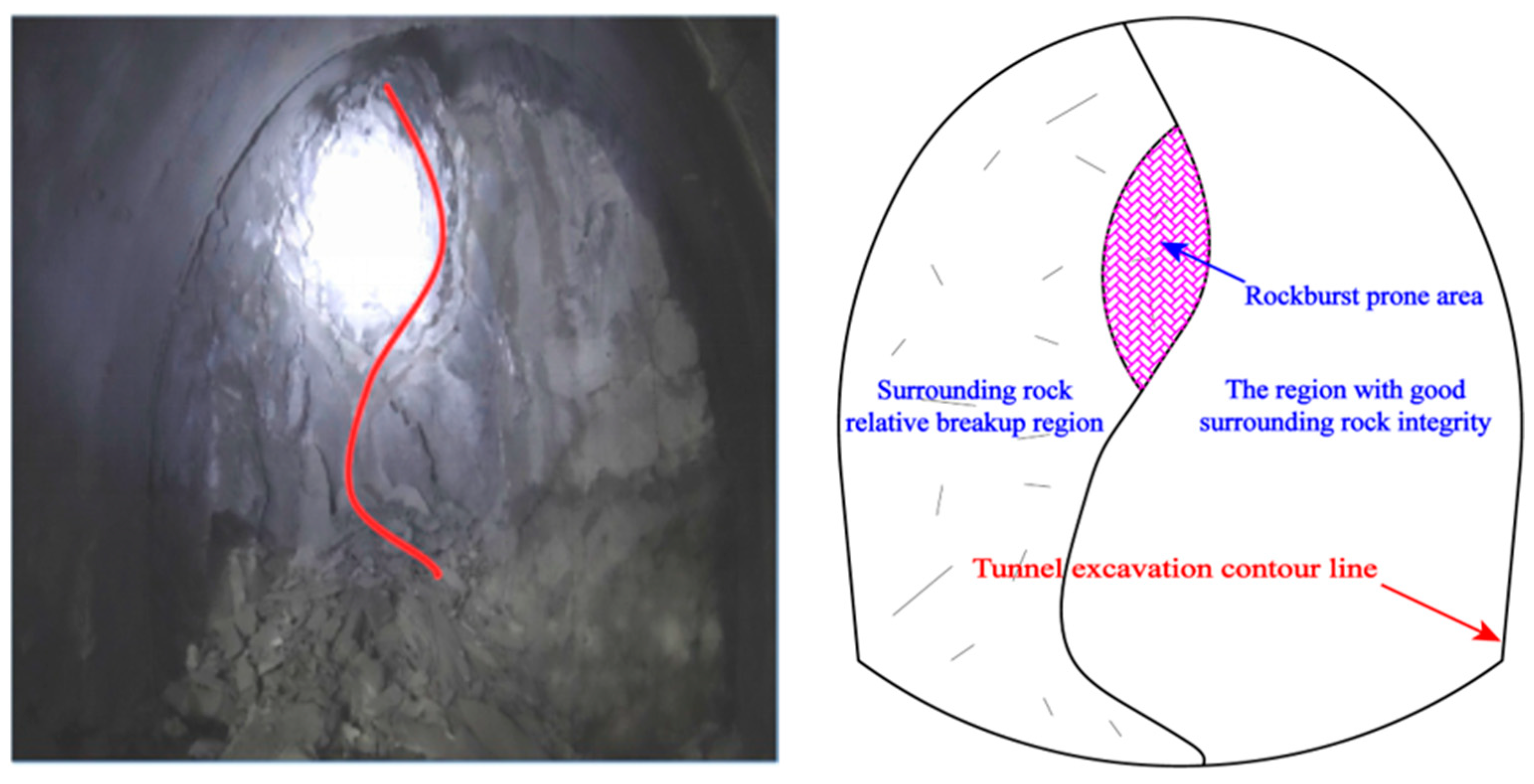
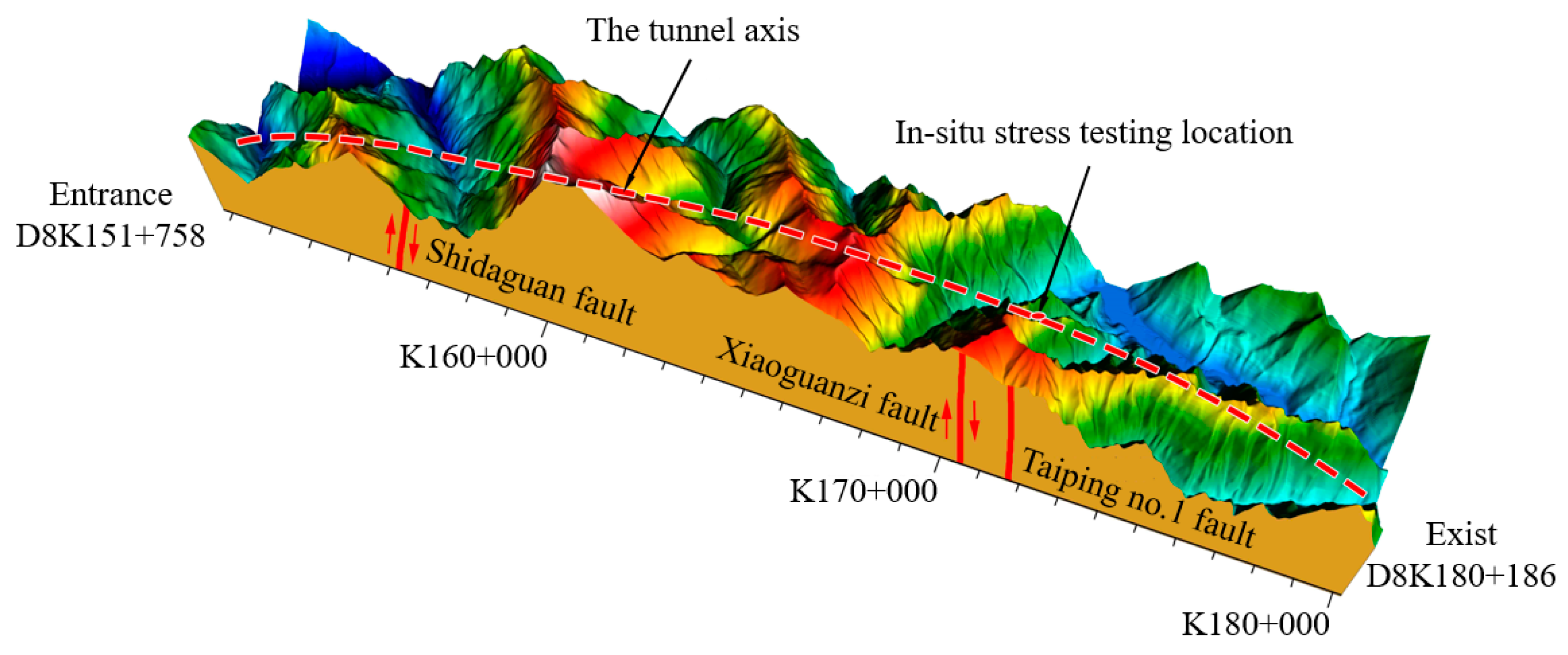
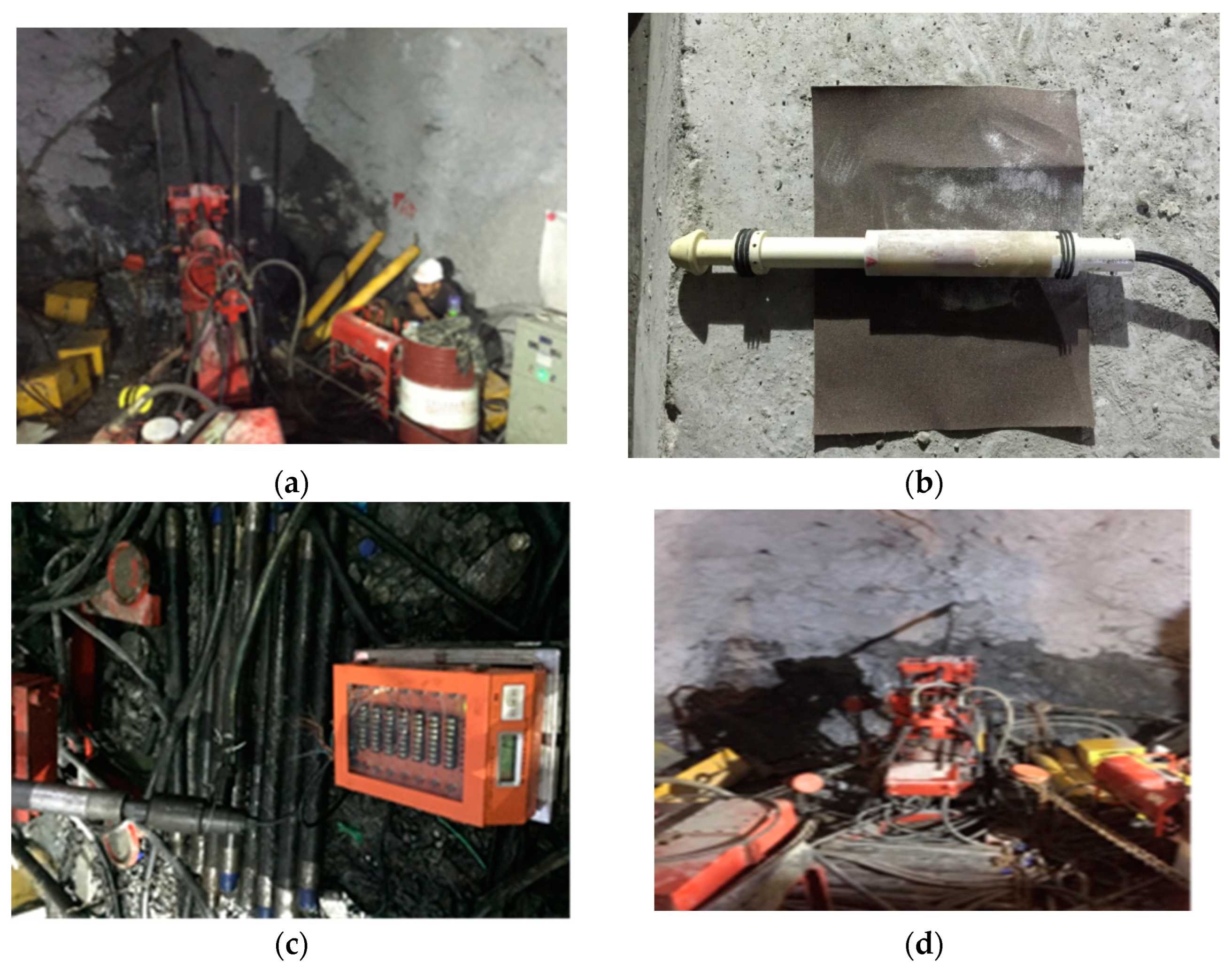
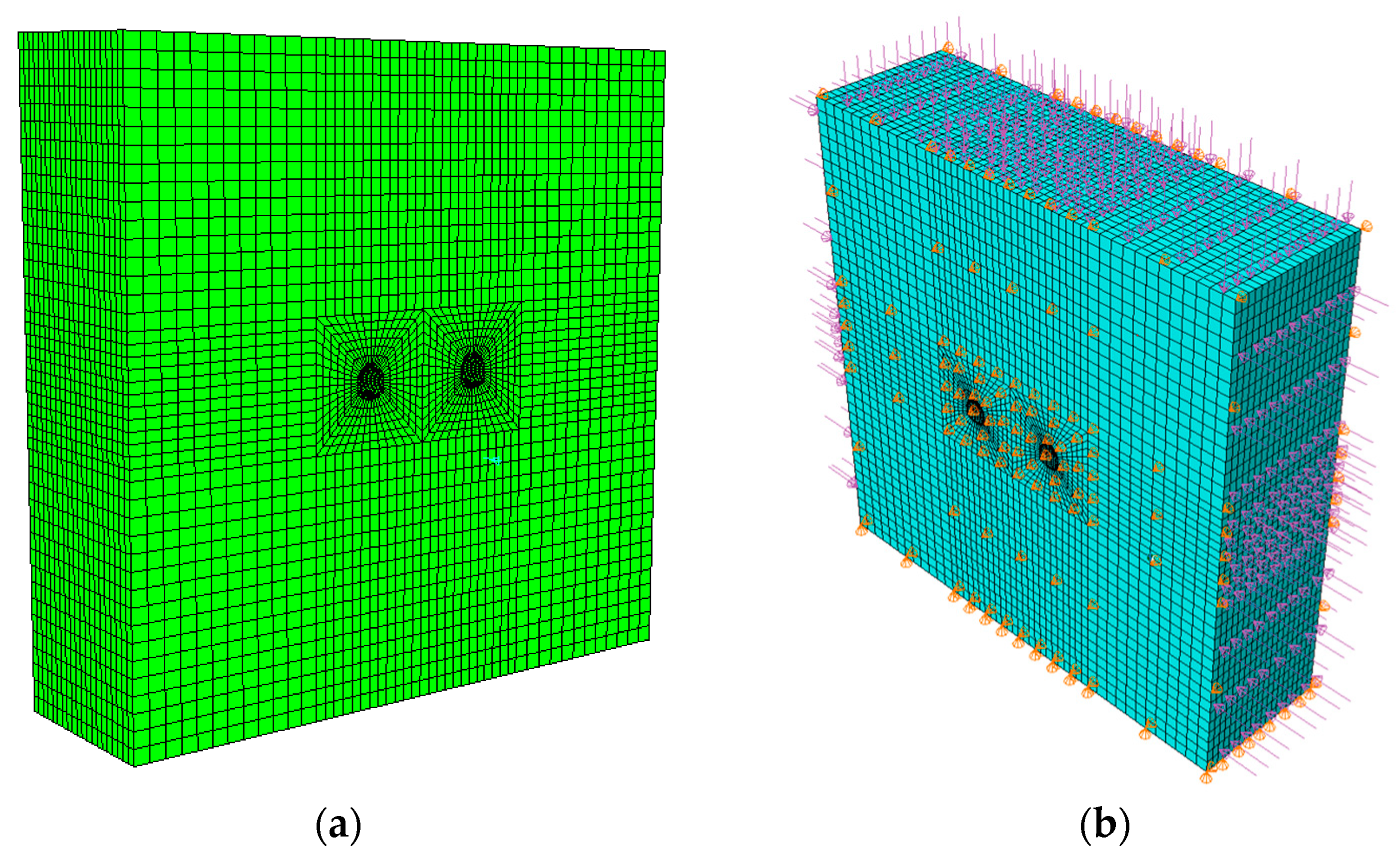
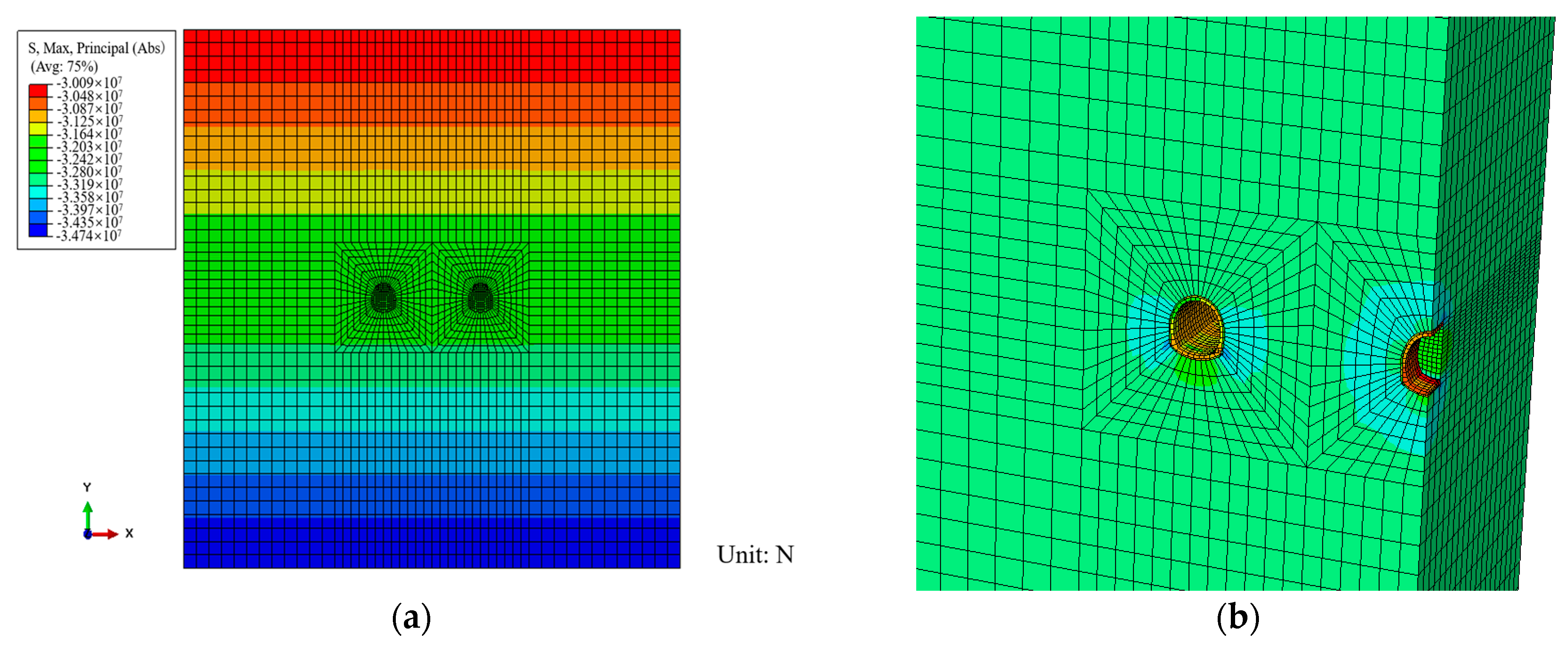

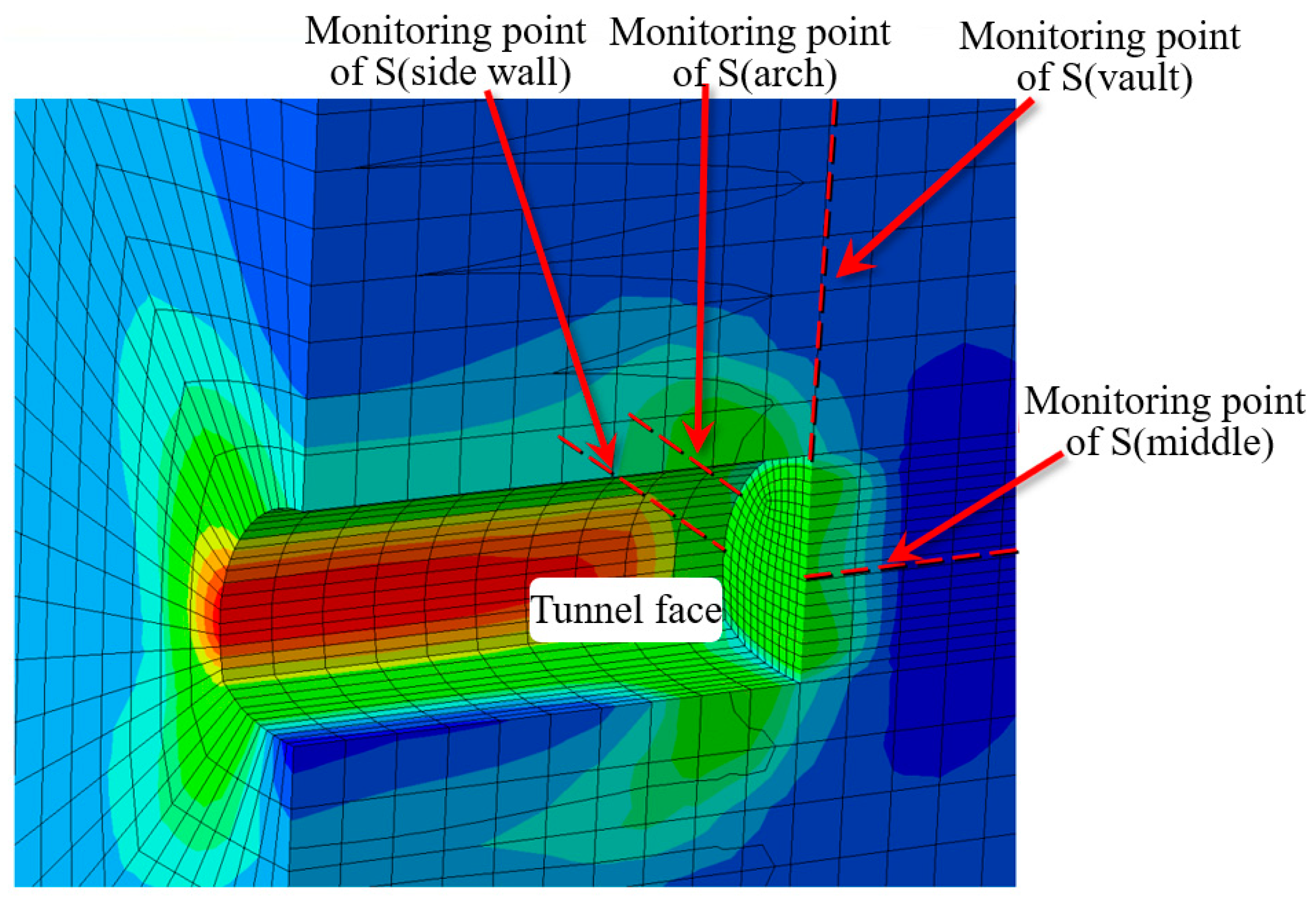
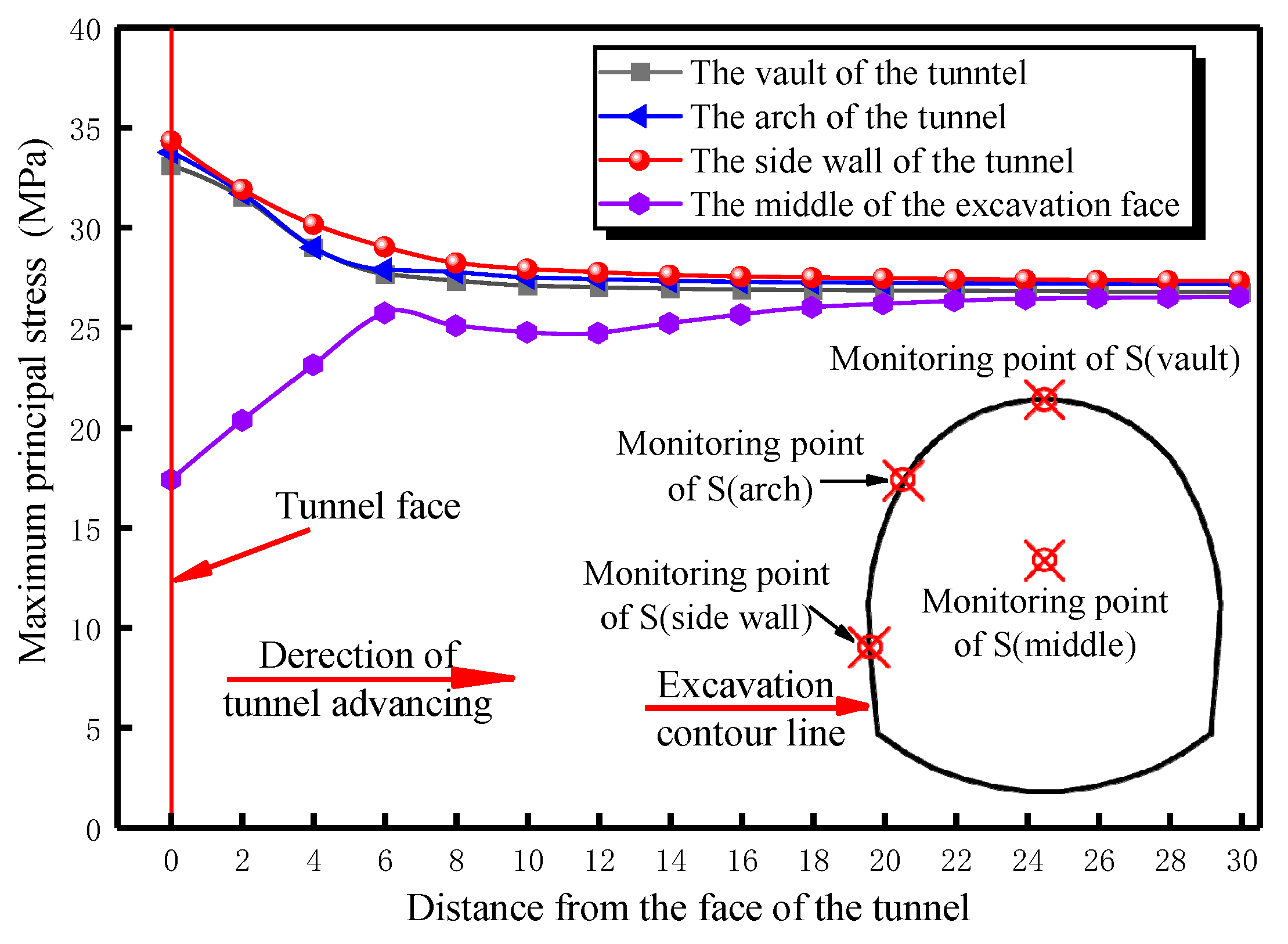
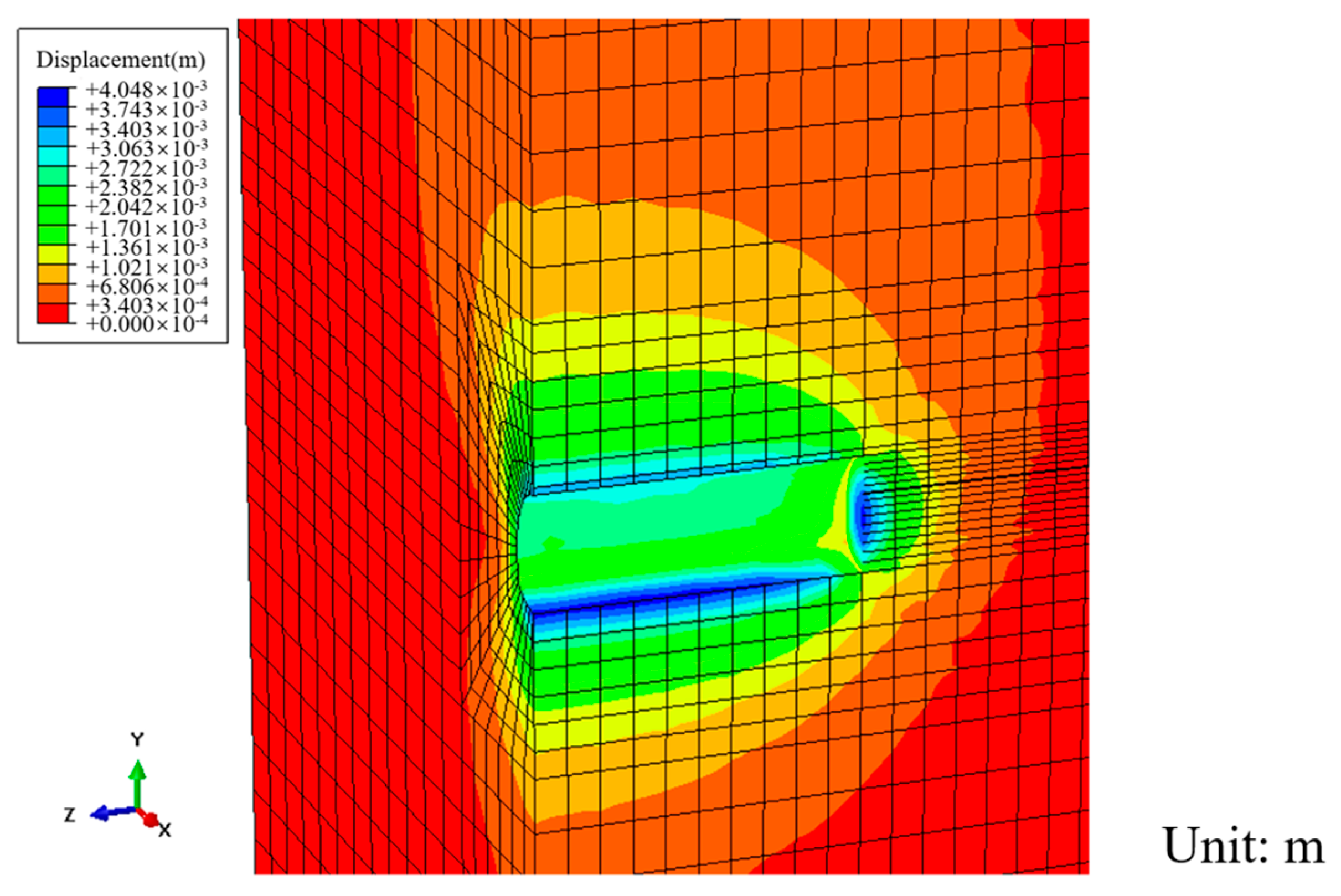
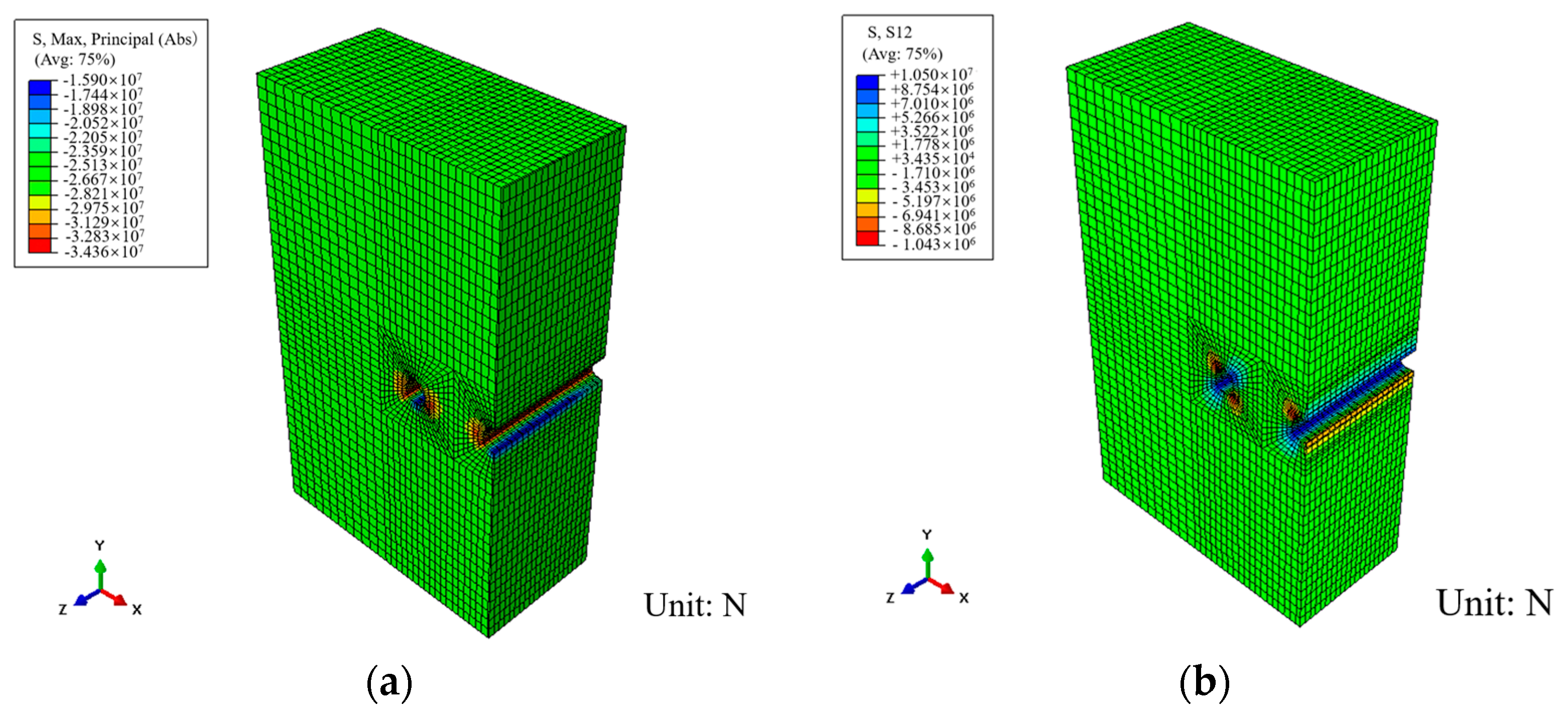

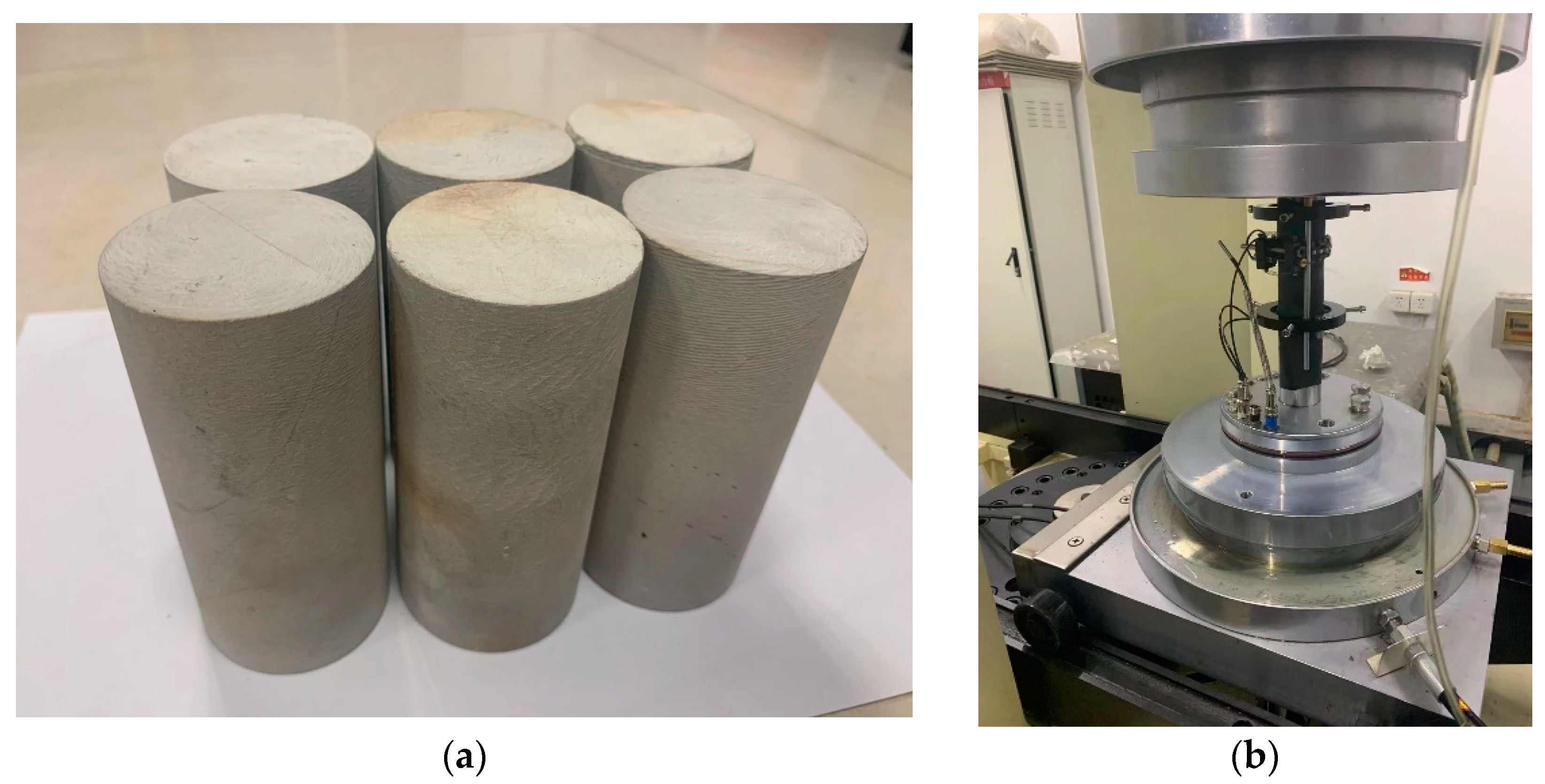

| Line | Slight Rockburst (m) | Medium Rockburst (m) | Strong Rockburst (m) | Total (m) |
|---|---|---|---|---|
| The left line of Ping’an Tunnel | 495 | 1310 | 510 | 2315 |
| The right line of Ping’an Tunnel | 457 | 1510 | 693 | 2560 |
| Total | 952 | 2820 | 1203 | 4875 |
| Location | In Situ Stress Parameter | Maximum Principal Stress σ1 | Intermediate Principal Stress σ2 | Minimum Principal Stress σ3 |
|---|---|---|---|---|
| D8K171+760 of Ping’an Tunnel | Stress value/MPa | 31.519 | 23.128 | 15.172 |
| Direction/° | NW194.688° | NW102.609° | NE63.848° | |
| Dip angle/° | ∠4.922° | ∠22.842° | ∠66.575° |
| Section | Volumetric Weight (kN/m3) | Cohesion (MPa) | Friction Angle (°) | Poisson’s Ratio | Elasticity Modulus (GPa) |
|---|---|---|---|---|---|
| Surrounding rock | 24.0 | 1.51 | 38.0 | 0.28 | 48.0 |
| Initial support | 24.5 | 1.64 | 33.7 | 0.16 | 30.0 |
| The second line | 24.5 | \ | \ | 0.20 | 33.5 |
| Lithology | Density (g/cm3) | Cohesion (MPa) | Frictional Angle (°) | Poisson’s Ratio | Elasticity Modulus (GPa) | (MPa) |
|---|---|---|---|---|---|---|
| Sandstone | 2.4 | 1.5 | 38 | 0.28 | 48 | 132.05 |
| Location | Maximum Principal Stress (MPa) | Criterion of Rockburst | Rockburst Rating on Site |
|---|---|---|---|
| Vault of the left tunnel | 32.63 | 4.05 (slight rockburst) | slight rockburst |
| Arch of the left tunnel | 32.76 | 4.03 (slight rockburst) | slight rockburst |
| Side wall of the left tunnel | 34.89 | 3.78 (medium rockburst) | medium rockburst |
| Middle of the left tunnel | 17.34 | 7.61 (no rockburst) | medium rockburst |
| Vault of the right tunnel | 34.11 | 3.87 (medium rockburst) | medium rockburst |
| Arch of the right tunnel | 32.86 | 4.01 (slight rockburst) | slight rockburst |
| Side wall of the right tunnel | 34.52 | 3.83 (medium rockburst) | medium rockburst |
| Middle of the right tunnel | 17.28 | 7.64 (no rockburst) | medium rockburst |
Disclaimer/Publisher’s Note: The statements, opinions and data contained in all publications are solely those of the individual author(s) and contributor(s) and not of MDPI and/or the editor(s). MDPI and/or the editor(s) disclaim responsibility for any injury to people or property resulting from any ideas, methods, instructions or products referred to in the content. |
© 2024 by the authors. Licensee MDPI, Basel, Switzerland. This article is an open access article distributed under the terms and conditions of the Creative Commons Attribution (CC BY) license (https://creativecommons.org/licenses/by/4.0/).
Share and Cite
Luo, C.; Zhang, S.; Tang, B.; Chen, J.; Yin, C.; Li, H. Research on Stress Characteristics of Rockburst in Over-Length Deep-Buried Tunnel. Buildings 2024, 14, 2298. https://doi.org/10.3390/buildings14082298
Luo C, Zhang S, Tang B, Chen J, Yin C, Li H. Research on Stress Characteristics of Rockburst in Over-Length Deep-Buried Tunnel. Buildings. 2024; 14(8):2298. https://doi.org/10.3390/buildings14082298
Chicago/Turabian StyleLuo, Chun, Shishu Zhang, Bihua Tang, Jun Chen, Chonglin Yin, and Huayun Li. 2024. "Research on Stress Characteristics of Rockburst in Over-Length Deep-Buried Tunnel" Buildings 14, no. 8: 2298. https://doi.org/10.3390/buildings14082298




